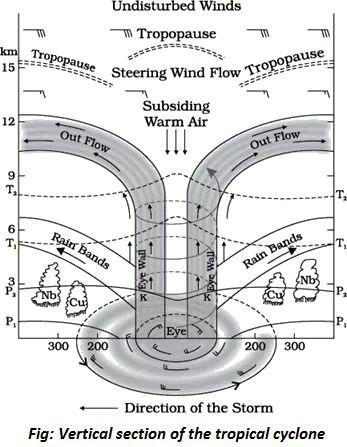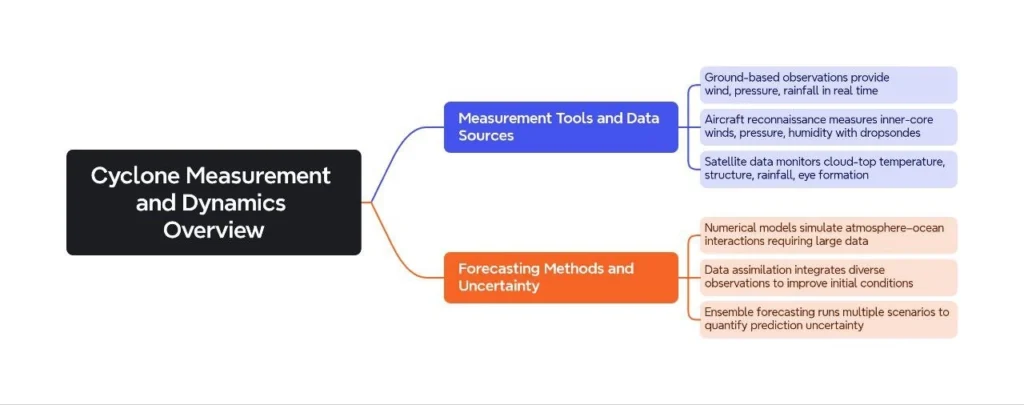Paper: GS – I, Subject: Geography, Topic: Geo – Physical Phenomenon, Issue: Cyclone Formation.
Context:
Cyclones are powerful rotating storms that form over warm tropical oceans. They act like natural heat engines drawing energy from warm seawater and converting it into violent winds, torrential rain, and destructive storm surges.
Key Takeaways:
- Depending on where they occur, they are called hurricanes (Atlantic), typhoons (Western Pacific), or tropical cyclones (Indian Ocean).

Cyclone Formation:
- Cyclones, also known as hurricanes or typhoons in different parts of the world, are powerful weather systems that draw energy from warm tropical waters.
- Their formation involves a combination of specific atmospheric and oceanic conditions:
- Low-Pressure Area: Cyclones typically begin as areas of low pressure, often associated with clusters of thunderstorms.
- Warm Sea Surface Temperature: A critical factor is warm sea surface temperatures, generally above 26.5°C, extending to a depth of at least 50 meters.
- This warm water provides the necessary energy for the cyclone to develop.
- Moist Air and Latent Heat: When moist air near the warm water surface rises, it cools and condenses, forming clouds. This condensation releases latent heat, which warms the surrounding air, causing it to rise further.
- Atmospheric Instability: The atmosphere must be unstable, meaning that rising air continues to rise rather than being forced back down.
- This instability allows the convection process to continue and intensify.
- Coriolis Force: The Coriolis force, caused by the Earth’s rotation, deflects circulating air. This deflection causes the air to curve, leading to the rotation characteristic of cyclones.
- The Coriolis effect is weakest near the equator, which is why cyclones rarely form within about five degrees of latitude from it.
- Low Vertical Wind Shear: Vertical wind shear, the difference in wind speed and direction between the lower and upper levels of the atmosphere, must be low.
- High wind shear can disrupt the cyclone’s organized circulation and prevent it from strengthening.
| Classification: There are two types of cyclones: Tropical cyclones; and Extra Tropical cyclones (also called Temperate cyclones or middle latitude cyclones or Frontal cyclones or Wave Cyclones).The World Meteorological Organization uses the term ‘Tropical Cyclone’ to cover weather systems in which winds exceed ‘Gale Force’ (minimum of 63 km per hour).Naming of Cyclones: The WMO/ESCAP (United Nations Economic and Social Commission for Asia and the Pacific) Panel on Tropical Cyclones, which includes 13 North Indian Ocean countries, manages cyclone naming for the Arabian Sea and Bay of Bengal. |
Cyclone Measurement and Dynamics Overview:

Despite the challenges, advances in computing power, remote sensing, and data assimilation have significantly improved cyclone forecasts over the past few decades. Today, most meteorological agencies can predict a cyclone’s track three to five days in advance with reasonable accuracy.
La Excellence IAS Academy, the best IAS coaching in Hyderabad, known for delivering quality content and conceptual clarity for UPSC 2025 preparation.
FOLLOW US ON:
◉ YouTube : https://www.youtube.com/@CivilsPrepTeam
◉ Facebook: https://www.facebook.com/LaExcellenceIAS
◉ Instagram: https://www.instagram.com/laexcellenceiasacademy/
GET IN TOUCH:
Contact us at info@laex.in, https://laex.in/contact-us/
or Call us @ +91 9052 29 2929, +91 9052 99 2929, +91 9154 24 2140
OUR BRANCHES:
Head Office: H No: 1-10-225A, Beside AEVA Fertility Center, Ashok Nagar Extension, VV Giri Nagar, Ashok Nagar, Hyderabad, 500020
Madhapur: Flat no: 301, survey no 58-60, Guttala begumpet Madhapur metro pillar: 1524, Rangareddy Hyderabad, Telangana 500081
Bangalore: Plot No: 99, 2nd floor, 80 Feet Road, Beside Poorvika Mobiles, Chandra Layout, Attiguppe, Near Vijaya Nagara, Bengaluru, 560040

